The USGA rootzone specification for greens construction and top dressing was developed nearly 60 years ago. It was designed to be managed with the technology of the time with a high input of inorganic fertilisers and powerful pesticides many of which are now banned. Many agronomists still recommend high inputs of sand, invasive aeration and scarification for thatch removal and programmed chemical management with growth regulators and high fungicide inputs as a way of managing these greens and pitches, in effect promoting 60-year-old technology.
Many greenkeepers and club managers find these outdated practices are no longer viable due to cost, lost play, golfer dissatisfaction and stress on the greenkeeper. It is time for the turf industry to move forward.
The USGA specification for construction and top dressing provides an excellent base from which to work with new techniques developed to remove the need for hollow coring and intensive scarification, improve drainage when wet and water retention when dry, reduce fertiliser and fungicide inputs and reduce the time greenkeepers spend on managing grass growth.
Where it’s going wrong
Compaction leading to poor infiltration rates, a build-up of thatch and anaerobic conditions are inbuilt design flaws of heavily used sand based golf greens and sports pitches. Most current thinking suggests that a physical solution to compaction is the only answer; consequently, a lot of the turf manager’s time and budget is taken up by the physical removal of thatch and hollow coring and top dressing with up to 200 tonnes of sand p.a. to dilute thatch, improve drainage and relieve compaction. This is time consuming, expensive, disruptive, uses finite resources, temporarily reduces the enjoyment of the game and results in lost play and lost income for the club.
Longer term, heavy top dressing stores up problems for later years, the organic material may become buried below the reach of most tines so oxygen is not available to convert it aerobically to humus, leading to root breaks and black layer. Heavy top dressing also dilutes the plant nutrients N,P, K, Ca, S, Mg, Cu, B, Zn, Mn, and reduces Cation Exchange Capacity (the nutrient holding capacity of the rootzone) requiring more fertiliser applications which in turn produces more thatch.
Finally introducing inert, sometimes sterilised, sand creates the bacterial dominant rootzone favoured by poa annua, all increasing future maintenance costs.
The alternative option
An alternative to physical disruption, thatch dilution and rootzone replacement is to compost the thatch in situ, convert it to plant food and humus and encourage natural processes to decompact the rootzone and incorporate these processes into the daily management of the, greens or any grass sports surface.
Healthy grassland soils comprise 50-60% soil particles, 15-25% air space and 15-25% water. You only have to take cores out of the rough of most golf courses to see that it is almost thatch free and friable because natural processes are at work. The key to easy turf management is to get these processes to work in the largely artificial environment of a sand based rootzone.
Organic matter is good
The first misconception to knock on the head is that organic matter is bad. It is not. Organic matter in the rootzone comprises roots, organic nutrients, humic compounds, partly degraded humus plus soil microbial life which most people agree is good. Too much thatch, which strictly speaking should be called organic material, is bad. When you use a loss on ignition test to measure organic matter all the good stuff gets mixed with the bad which can give a very misleading result.
Humus retains moisture, increases Cation Exchange Capacity (the nutrient holding capacity of the rootzone) acts as a support for soil microbiology and creates the air and water space necessary for root growth, rapid percolation and nutrient recycling.
So how can greens and pitches be managed without coring and heavy scarification?
Fungi, actinomycetes and bacteria degrade thatch and convert it to humus in situ. If the microbes needed are missing they can easily be added. Products containing thatch eating fungi and bacteria have been available for over 25 years and there is a wide range of options from microbial inoculants to compost teas available to the turf manager to degrade thatch. Symbio Thatch Eater also carries the benefit of a product replacement guarantee if the user is not completely satisfied with the result.
Oxygen the best biostimulant
The most effective way to get oxygen evenly distributed throughout the rootzone is to combine frequent tinning with 6-8ml block tines, that hardly disrupt the surface, with sorrel rolling that penetrates to the bottom of the thatch layer, every 2-3 weeks. This may be augmented with slitting in winter when moisture levels allow.
There are also a number of liquid applications like Symbio Liquid Aeration that contain high numbers of oxygen atoms which when sprayed allow oxygen to become available throughout the rootzone.
Hollow coring does not evenly oxygenate the soil. - You can see from the pictures in FIgure 1 that hollow coring once or twice a year has very little effect on black layer, the black layer has not broken down because oxygen has only travelled a couple of millimetres from the tine hole. However when regular micro tinning and microbiology was applied via compost teas the rootzone became clean, friable and humus rich in the space of a year.
Figure 1
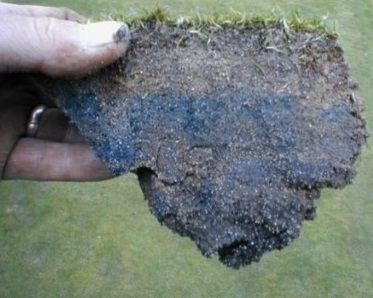
2006, before coring – Typical anaerobic rootzone
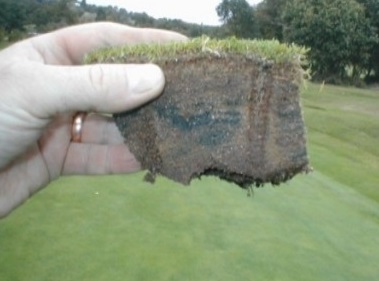
2009, 3 years of coring – black layer still present very close to hollow core holes due to poor oxygen transfer

2011, 2 years of compost tea and microtinning – friable, low thatch, rootzone after applying compost teas and microtinning.
Nature works in several ways to create the correct air and water spaces in the rootzone
Bacteria and fungi produce polysaccharides to help them adhere to surfaces and to prevent them from drying out. The polysaccharides are sticky substances which clump fine soil particles together forming air space in between.
Fungal hyphae grow through the root zone pushing soil particles apart. There is over 1 tonne of fungi per hectare in a healthy root zone and many fungi form mycorrhizal associations to extract and transport nutrients and water through the root zone to benefit the plant.
Nematodes often get a bad press from turf managers but relatively few are plant parasitic. Most live in soil on bacteria and fungi or other nematodes. Nematodes play an important role in soil improvement they are like small worms up to 0.5mm long and as they move through the root zone they push soil particles apart, depositing ammonium as they go. Root hairs then colonise the space and further improve friability.
Earthworms most of which do not form casts are also create wide air spaces and drainage channels.
Composting thatch on the green
Thatch is mostly lignin which needs fungi and actinomycetes to digest it and break it down. You can see this from the attached picture Figure 2. A green with very deep, dense thatch was hollow cored twice a year for two years, regularly tinned and 200 tonnes/hectare p.a. of sand applied. With almost no positive result. After two years the greenkeeper switched to a biological approach. He applied Symbio Thatch Eater, stopped hollow coring, reduced sand inputs to 120 tonnes p.a. and tinned every two weeks with 6ml block tines. After two years of this regime the thatch had almost completely gone leaving an aerated, friable root zone.
Figure 2
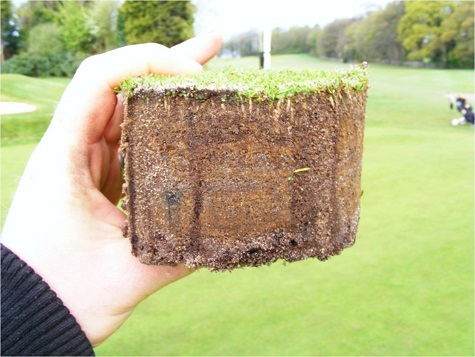
Almost no thatch reduction after two years of hollow coring and 200 tonnes top dressing p.a.

Thatch has disappeared 2 years after application of Symbio ThatchEater and 120 tonnes top dressing p.a.
Creating a fast draining root zone
To naturally maintain free draining rootzones you need a minimum of 2-2.5% w/w humus or humic compounds in the rootzone and until the thatch is completely mineralised which can take up to 30 years humic compounds show up on the loss on ignition test to measure “organic matter”.
The positive effect of humus cannot be overemphasised. It turns the rootzone to a rich brown colour so it is easy to see if you have enough.
Figure 3 below shows the speed with which the transformation can take place, the pictures were taken just 60 days apart in April and June 2018 at Greenburn Golf Club in a fairly wet area of Scotland, aeration was provided by solid 8mm tines and small spikes together with Symbio Liquid Aeration, microbial inoculants and biostimulants.
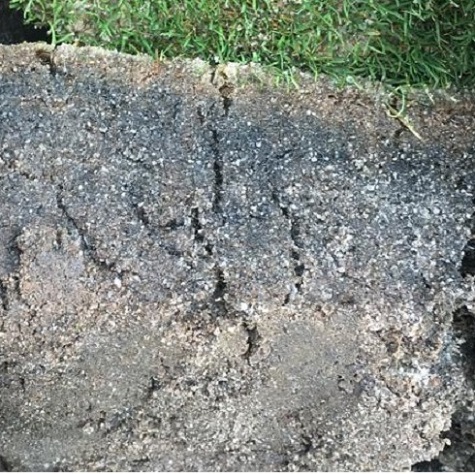
Conventional management after a wet winter 3.4.2018
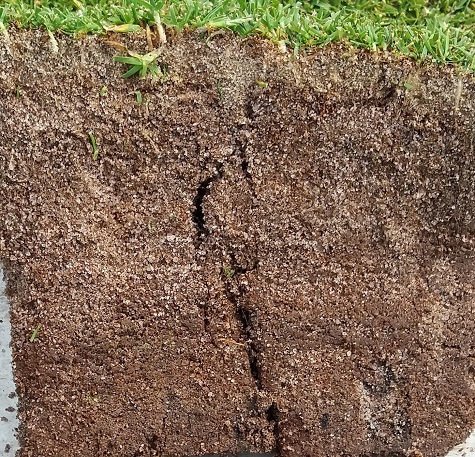
Humus rich, well draining, rootzone 2 after just 2 months of microbial management and solid tines
Figure 4 below shows the improvement in rootzone and root depth that takes place when an old top dressed rootzone converts from purely physical and chemical management to a holistic approach incorporating soil biology with the use of microbial products and biostimulants from Symbio.

Heavy compact rootzone with conventional management
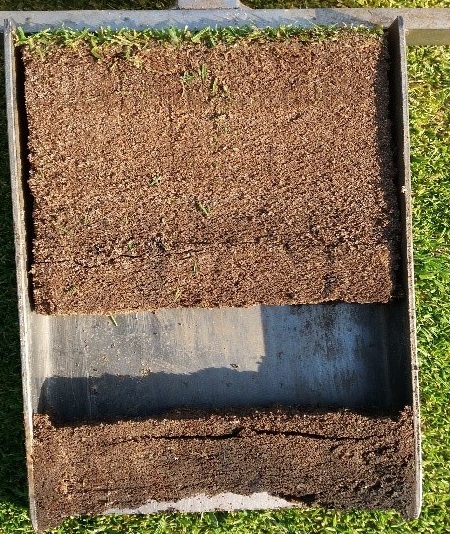
Free draining rootzone with extended rootsystem with solid tines and biological management
Golfers and sportsmen demand the highest standards with minimal disruption, so managing our playing surfaces in the most cost efficient manner is paramount.
If we take a look at the savings made when managing healthy soil we can see that potential savings on 100 tonnes or more of top dressing a year, the reduced investment in machinery and blade maintenance, reduced course closures, more efficient use of man power, reduced fertiliser and fungicide use and more green fee income taken together with the abolition of “maintenance week” will make a sizeable improvement to almost every clubs' finances.